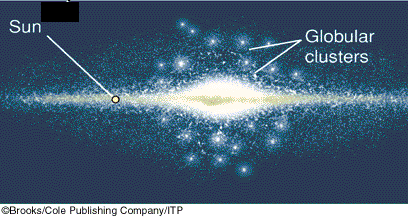
The European Southern Observatory’s infrared VISTA telescope has discovered ancient stars – known as RR Lyrae stars – in the center of our Milky Way. This is the first time anyone has seen this sort of star at the galaxy’s center. RR Lyrae stars are commonly found in globular clusters, those vast symmetrical clusters that lie outside the disk of our galaxy and contain some of its oldest stars. The discovery of RR Lyrae stars at the heart of our Milky Way suggests to these astronomers that the bulging center of our galaxy likely grew through the merging of primordial globular star clusters. These stars may even be the remains of our galaxy’s most massive and oldest surviving star cluster.
This work is published October 12, 2016 in the peer-reviewed Astrophysical Journal Letters.
Dante Minniti of Universidad Andrés Bello in Chile and Rodrigo Contreras Ramos of the Instituto Milenio de Astrofísica in Chile used observations from the VISTA infrared survey telescope to find a dozen ancient RR Lyrae stars at the heart of the Milky Way that were previously unknown. Their statement explained:
RR Lyrae stars are typically found in dense globular clusters. They are variable stars, and the brightness of each RR Lyrae star fluctuates regularly. By observing the length of each cycle of brightening and dimming in an RR Lyrae, and also measuring the star’s brightness, astronomers can calculate its distance.
Unfortunately, these excellent distance-indicator stars are frequently outshone by younger, brighter stars and in some regions they are hidden by dust. Therefore, locating RR Lyrae stars right in the extremely crowded heart of the Milky Way was not possible until [a survey] was carried out using infrared light. Even so, the team described the task of locating the RR Lyrae stars in amongst the crowded throng of brighter stars as ‘daunting.’
Their hard work was rewarded, however, with the identification of a dozen RR Lyrae stars. Their discovery indicate that remnants of ancient globular clusters are scattered within the center of the Milky Way’s bulge.
This discovery – RR Lyrae stars in the heart of our Milky Way – may help astronomers decide between two competing theories for how these bulges form at the center of galaxies like ours. One theory suggests that galactic bulges form through the merging of globular star clusters. The competing hypothesis is that these bulges form due to the rapid accretion [accumulation via gravity] of gas. Rodrigo Contreras Ramos said:
The evidence supports the scenario in which the bulge was originally made out of a few globular clusters that merged.


Bottom line: Astronomers have used an infrared telescope in Chile – called VISTA – to discover RR Lyrae stars in the center of our Milky Way galaxy. As RR Lyrae stars typically reside in ancient globular clusters over 10 billion years old, this discovery suggests that the bulging center of the Milky Way likely grew through the merging of primordial star clusters.











